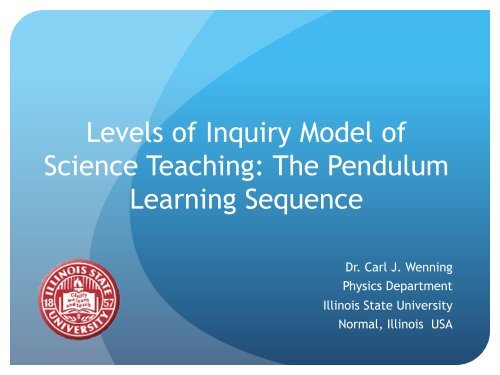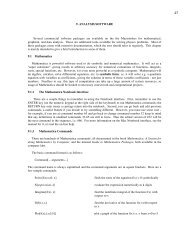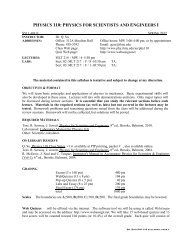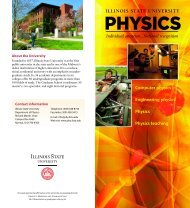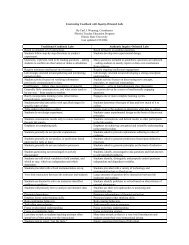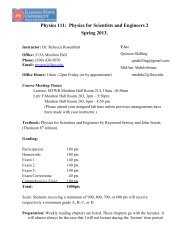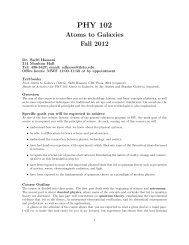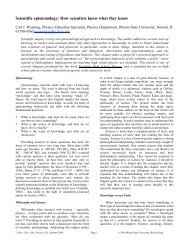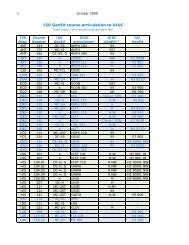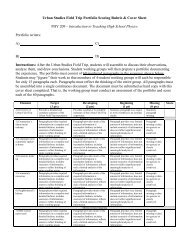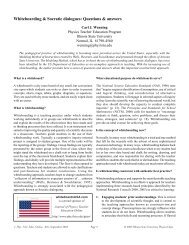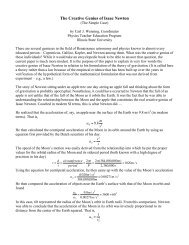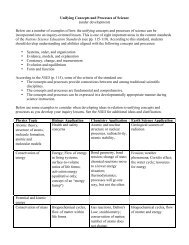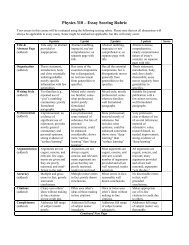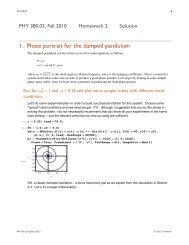Levels of Inquiry Model of Science Teaching: The Pendulum ...
Levels of Inquiry Model of Science Teaching: The Pendulum ...
Levels of Inquiry Model of Science Teaching: The Pendulum ...
Create successful ePaper yourself
Turn your PDF publications into a flip-book with our unique Google optimized e-Paper software.
<strong>Levels</strong> <strong>of</strong> <strong>Inquiry</strong> <strong>Model</strong> <strong>of</strong><br />
<strong>Science</strong> <strong>Teaching</strong>: <strong>The</strong> <strong>Pendulum</strong><br />
Learning Sequence<br />
Dr. Carl J. Wenning<br />
Physics Department<br />
Illinois State University<br />
Normal, Illinois USA
<strong>Levels</strong> <strong>of</strong> <strong>Inquiry</strong> Method<br />
<strong>of</strong> <strong>Science</strong> <strong>Teaching</strong><br />
Discovery<br />
Learning<br />
Interactive<br />
Demonstration<br />
<strong>Inquiry</strong><br />
Labs<br />
Real-world<br />
Application<br />
Hypothetical<br />
Explanation<br />
Each level <strong>of</strong> inquiry has associated with it different<br />
intellectual process skills. For example,<br />
Discovery learning – developing concepts<br />
Interactive demonstration – predicting and testing<br />
<strong>Inquiry</strong> lesson – designing a controlled experiment<br />
<strong>Inquiry</strong> labs – collecting and analyzing data<br />
Real-world application – solving authentic problems<br />
Hypothetical explanation – developing testable explanations
Level 1: Discovery Learning<br />
Students reflect on their mental models <strong>of</strong> pendulums<br />
by discussing various examples they have encountered.<br />
Students “play” with a pendulum without aid <strong>of</strong> time or<br />
distance measuring devices in order to determine the<br />
easily identifiable aspects <strong>of</strong> the system that can be<br />
directly measured. Terms are applied to new concepts<br />
such as length, period, amplitude, and mass.<br />
<strong>The</strong> concept <strong>of</strong> the simple pendulum is distinguished<br />
from that <strong>of</strong> the physical pendulum by comparing a<br />
swinging ball on a 1m string with a meter stick.
Level 2: Interactive Demonstration<br />
<strong>The</strong> teacher sets up a simple pendulum with a length <strong>of</strong><br />
20cm and demonstrates its motion and period reviewing<br />
concepts developed during discovery learning.<br />
<strong>The</strong> teacher asks, “What would happen if I would halve/<br />
double the length <strong>of</strong> the pendulum?” Students predict,<br />
write down their prediction, and then observe the<br />
result.<br />
<strong>The</strong> teacher asks, “What would happen if I would<br />
quarter/quadruple the length <strong>of</strong> the pendulum?”<br />
Students predict, write down their prediction, and then<br />
observe the result. “Do you see a relationship here?”
Level 3: <strong>Inquiry</strong> Lesson<br />
Students participate as instructor leads a lesson about<br />
the simple pendulum using a “think aloud” protocol.<br />
Students predict which factors influence the period <strong>of</strong> a<br />
simple pendulum, and suggest how they might affect it.<br />
Students identify relationships between all significant<br />
factors and period <strong>of</strong> the simple pendulum.<br />
P is a function <strong>of</strong> length.<br />
P is slightly dependent upon amplitude.<br />
P is not a function <strong>of</strong> mass.
Level 4: <strong>Inquiry</strong> Lab<br />
Length and period data are collected and graphed using a<br />
controlled experiment (amplitude is held constant).<br />
Students graph data and determine that period is<br />
proportional to the square root <strong>of</strong> pendulum length.<br />
Extension: Students test different amplitudes to determine<br />
the limitation <strong>of</strong> the accuracy <strong>of</strong> the discovered relationship<br />
relationship, P = (2.006s/m ½ )l ½<br />
Comparing experimental values <strong>of</strong> period for various<br />
amplitudes with predicted values from small angle formula,<br />
students determine at what angle (amplitude) the predicted<br />
period diverges from the actual period by more than 5%.
Graphical Analysis Results<br />
Initial Graph<br />
Linearized Graph
Level 5: Real-world Application<br />
Students use a simple pendulum and the theoretical<br />
relationship, P = 2π(l/g) ½ , to accurately determine the<br />
local value <strong>of</strong> the acceleration due to gravity, g.<br />
Extension: Students perform error analysis by seeing<br />
how errors in period, P, and length, l, <strong>of</strong> the pendulum<br />
propagate to g. That is,<br />
Δg = g(Δl/l+2ΔP/P)<br />
See Error Propagation in the ISU Physics Teacher<br />
Education advanced Student Laboratory Handbook.
Level 6: Hypothetical Explanation<br />
Students “extract” the value <strong>of</strong> g from the discovered<br />
proportionality constant, 2.006s/m ½ , using dimensional<br />
analysis.<br />
<strong>The</strong> remaining constant, 6.283, turn out to be 2π.<br />
See ISU’s Student Laboratory Handbook at<br />
http://www.phy.ilstu.edu/pte/302content/<br />
student_lab_hdbk/slh.html - See Reconciling<br />
Experimental with <strong>The</strong>oretical Relationships
To learn more about the <strong>Levels</strong> <strong>of</strong><br />
<strong>Inquiry</strong> Method <strong>of</strong> <strong>Science</strong> <strong>Teaching</strong><br />
<strong>Levels</strong> <strong>of</strong> inquiry: Hierarchies <strong>of</strong> pedagogical practices and<br />
inquiry processes. Journal <strong>of</strong> Physics Teacher Education<br />
Online, 2(3), February 2005, pp. 3-11.<br />
<strong>Levels</strong> <strong>of</strong> inquiry: Using inquiry spectrum learning sequences<br />
to teach science. Journal <strong>of</strong> Physics Teacher Education<br />
Online, 5(4), Summer 2010, pp 11-19.<br />
<strong>The</strong> <strong>Levels</strong> <strong>of</strong> <strong>Inquiry</strong> <strong>Model</strong> <strong>of</strong> <strong>Science</strong> <strong>Teaching</strong>. Journal <strong>of</strong><br />
Physics Teacher Education Online, 6(2), Summer 2011, 9-16<br />
Sample learning sequences based on the <strong>Levels</strong> <strong>of</strong> <strong>Inquiry</strong><br />
<strong>Model</strong> <strong>of</strong> <strong>Science</strong> <strong>Teaching</strong> including Appendix (with Manzoor<br />
Ali Khan). Journal <strong>of</strong> Physics Teacher Education Online, 6(2),<br />
Summer 2011, 17-30.


